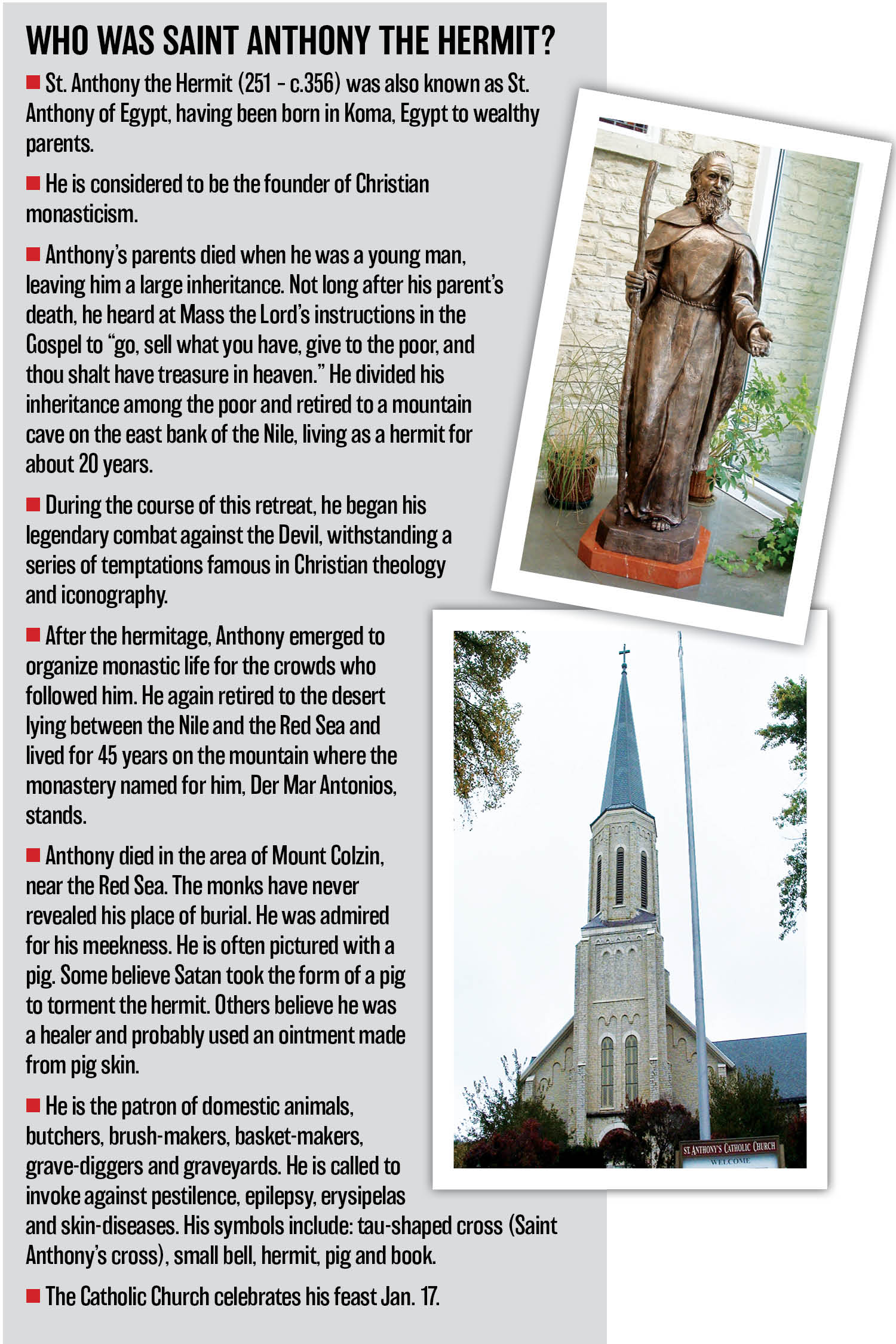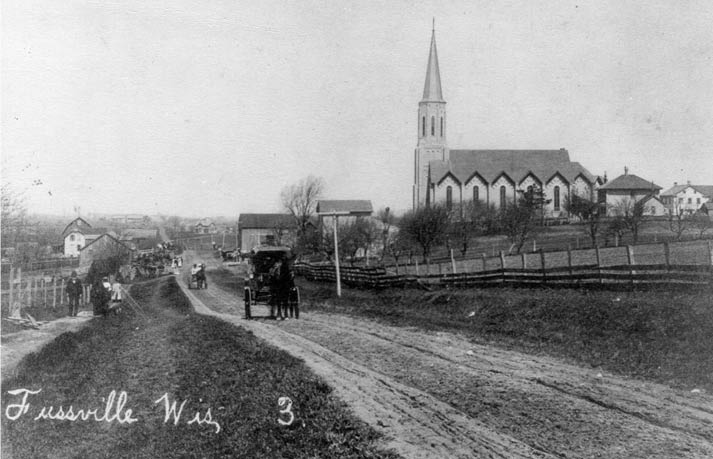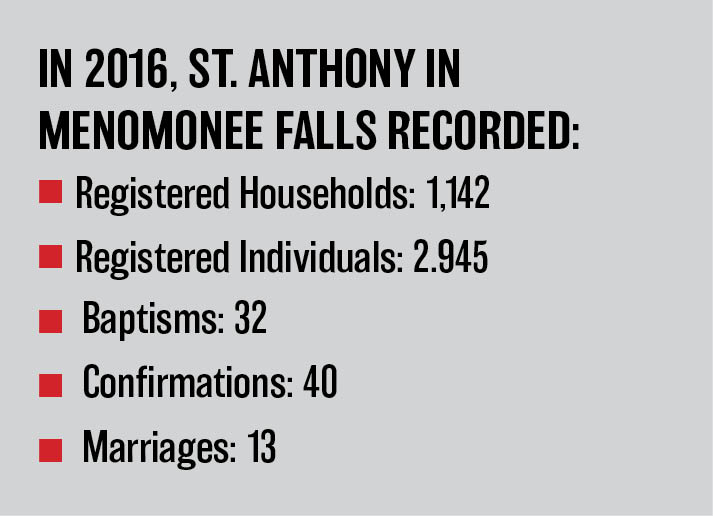“Our church is made up of the old and the new…”
– Carole McGibany, author and church historian
It’s the story of the Menomonee and the Chippewa tribes who gathered, farmed and lived off this land long before the first white immigrant settlers began to arrive from Europe. First, the Irish in the 1830s and then the Germans a decade later.
It’s the story of how a solitary deer trail once marked a wooded throughway that would later evolve into Fond du Lac Road, a rough dirt course charted by horses and wagons and, ultimately, into four lanes of concrete and gasoline-powered automobiles known today as Appleton Avenue. 
And it’s the story of a church that still stands on the hill upon which it was dedicated in 1867, welcoming people of all backgrounds to come to worship in greater numbers than ever before. A church named after St. Anthony The Hermit in the village of Menomonee Falls.
This area, which would come to be known as ‘Fussville,’ was settled in 1837 by Native Americans and early Irish immigrants. But less than 10 years later, the early farms and land were sold to another group of immigrants who arrived from Germany. In 1844, the ship CATO left Antwerp with its passengers seeking a better life in America. On board were John Castenholz, his wife Mary Sybilla and her 1-year-old daughter, Clara, along with three of Sybilla’s brothers: J.W. Fuss, William Henry Fuss and Mathias Fuss.
Arriving in Wisconsin, the Castenholz and Fuss families bought parcels of land near what would become Fond du Lac Road and worked them into some of the finest farms in the area. The new roadway afforded easy access to Milwaukee and Granville to the south and the Fox River Valley to the north.
“On Christmas Eve 1844, on what today is the northeast corner of Appleton Avenue and Lilly Road, legend has it that the first Catholic Mass was said in one of Castenholz’s outbuildings,” said Carole McGibany, St. Anthony’s volunteer church historian who will soon release a new book, “Glimpses,” tracing the history of this area and St. Anthony’s particular role in that history. The book is due out in December.
The next year, the patriarch of the family, Johan Fuss, arrived along with his wife Clara, their three daughters and several of their neighbors from the village of Nierderdrees, Prussia. These, along with Fuss’s four remaining grown children and their families, all settled in the Fussville area.
Johan Fuss was none too pleased that the nearest church was 3 miles away and he prayed that “we will have a church of our own someday.” Soon, they built the first log church on the current site of the statue of the Good Shepard, right behind today’s St. Anthony grade school. However, the church quickly became obsolete as the flow of immigrants continued.
“By the 1850s, we needed a second church and it was built a little closer to our existing church of today,” said McGibany. “And still the immigrants came and the church was too small so, in 1867, the new church building was dedicated and it was known at the time as one of the most spectacular stone rural churches in southeastern Wisconsin. Legend says the people took their horses and wagons and hauled the Lannon stone from a nearby quarry to bring it here. The church was built by those founding families.”
That strong sense of faith community has transcended generations all the way to the St. Anthony’s church of today.
“What I’ve learned about this community is that the history is extraordinary, and there’s a commitment and dedication of the people who have been here all their lives,” said Msgr. Ross Shecterle, who’s been administrator of both St. Anthony’s and neighboring St. Mary’s parish for just three months. “There’s an energy and enthusiasm about who they are as people of faith.”
Perched on that hill overlooking Appleton Avenue, St. Anthony’s in a way symbolizes the whole area’s blend of the old and new. Just a stone’s throw to the southeast is North Hills Country Club, which is listed on the National Register of Historic Places and preserves the rolling hills and beautiful groves of trees that marked those early farmlands. 
Inside the church, the blend of old and new is even more evident. The church was renovated in 2006, but while it features a larger, wide open sanctuary area, the original Lannon stone walls and ornate altar are wonderfully preserved.
“It was clear to me that when people tell the story of the church renovation in 2006 they were adamant that they retain and maintain as much of the old church as possible as they expanded into the new,” said Shecterle. “They blew out one wall of the church but kept the three fieldstone walls of the church as anchors as it expands outward. That said something about who they were as a community as well as the creativity of the architect.”
With a theme of “Welcoming the Future and Embracing the Past,” the renovation was suggested by the Archdiocese of Milwaukee to alleviate overcrowding for Masses.
“They really felt that for us to continue in the future, we needed to be bigger than 300-plus,” recalled McGibany. “We had many, many parishioners who had ancestors who were founding families of this church so they insisted that some things stay (as they were). The altar is one of those. Light fixtures were turned into votive candles. On each side of the altar there were side altars made of marble. That marble was also repurposed for the bases of Mary’s and St. Anthony’s statues as well.”
The St. Anthony statue immediately catches your eye as you walk into the new, glass-enclosed gathering space and main entrance to the church. Walk through the door into the sanctuary and you are immediately surrounded by the well-preserved stone walls graced with stained glass windows depicting the story of Christ’s salvation. Straight ahead lies a vast seating area with the beautiful new altar. 
“As a community, we are like the church — a blend of the old and the new,” said McGibany. “We still have Foss, Wick and there are descendants from Fuss and Schmidt, all founding families in the 1840s. But we can accommodate so many more.”
“This is a very generous, very caring and very faithful group of people,” added Shecterle. “I’ve been told more than once that they have a great fish fry (first Friday of each month, 4 to 7 p.m. in the school hall). They care about each other, they care about their faith and if anyone came to Mass here they would have a very prayerful experience in a very welcoming community.”
